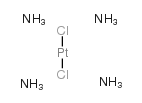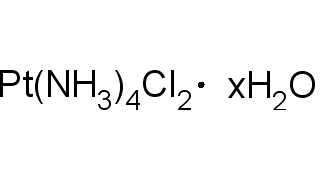四氨合氯化铂,水合物, 99%,Tetraammineplatinum chloride hydrate
产品编号:西域试剂-WR363739| CAS NO:13933-32-9| MDL NO:MFCD00149947| 分子式:H12N4PtCl2·xH2O| 分子量:334.11(anhydrous basis)
本网站销售的所有产品仅用于工业应用或者科学研究等非医疗目的,不可用于人类或动物的临床诊断或者治疗,非药用,非食用,
| 产品名称 | 四氨合氯化铂,水合物, 99% |
|---|---|
| 英文名称 | Tetraammineplatinum chloride hydrate |
| CAS编号 | 13933-32-9 |
| 产品熔点 | 250(分解温度) |
| 精确质量 | 333.00900 |
| PSA | 12.96000 |
| LogP | 2.67210 |
| 稳定性 | 常温常压下不稳定 避免的物料:水溶液与碱金属,碱土金属和许多有机无机的活性化学药品是不相溶的 |
| 储存条件 | 常温密闭避光,通风干燥 |
相关文档
化学品安全说明书(MSDS)
下载MSDS质检证书(COA)
相关产品
| 危害码 (欧洲) | Xn:Harmful; |
|---|---|
| 风险声明 (欧洲) | R20/21/22;R36/37/38 |
| 安全声明 (欧洲) | S26-S37/39 |
| RTECS号 | TP2507150 |
|
Section 1: Product Identification Chemical Name:Tetraammineplatinum (II) chloride monohydrate, 99% (99.95%-Pt) CAS Registry Number:13933-32-9 Formula:[Pt(NH3)4]Cl2.H2O EINECS Number:237-706-5 Chemical Family:metal-ammine complexes Synonym:Platinum(2+), tetraammine-, dichloride, (SP-4-1)-,
Section 2: Composition and Information on Ingredients IngredientCAS NumberPercentACGIH (TWA)OSHA (PEL) Title Compound13933-32-9100%0.002mg/m3(as-Pt)0.002mg/m3(as-Pt) Section 3: Hazards Identification Exposure to platinum compounds has been shown to cause wheezing, coughing, and running of the nose. Emergency Overview: Skin contact can lead to dermatitis. Primary Routes of Exposure:Ingestion, inhalation, skin Eye Contact:Causes mild to moderate irritation of the eyes. Skin Contact:Causes slight to mild irritation of the skin. Inhalation:Inhalation of the dust may cause wheezing, coughing, shortness of breath. Ingestion:Ingestion may lead to dizziness, abdominal cramps, vomiting, bloody diarrhea, weakness, and convulsions. Irritating to skin, eyes and respiratory tract. Exposure to platinum compounds may lead to wheezing, coughing, Acute Health Affects: and running of the nose. Skin exposure may lead to dermatitis. Chronic Health Affects:No information available on long-term chronic effects. NTP:No IARC:No OSHA:No SECTION 4: First Aid Measures Immediately flush the eyes with copious amounts of water for at least 10-15 minutes. A victim may need Eye Exposure: assistance in keeping their eye lids open. Get immediate medical attention. Wash the affected area with water. Remove contaminated clothes if necessary. Seek medical assistance if Skin Exposure: irritation persists. Remove the victim to fresh air. Closely monitor the victim for signs of respiratory problems, such as difficulty Inhalation: in breathing, coughing, wheezing, or pain. In such cases seek immediate medical assistance. Seek medical attention immediately. Keep the victim calm. Give the victim water (only if conscious). Induce Ingestion: vomiting only if directed by medical personnel. SECTION 5: Fire Fighting Measures Flash Point:not applicable Autoignition Temperature:none Explosion Limits:none Extinguishing Medium:carbon dioxide, foam or dry powder If this product is involved in a fire, fire fighters should be equipped with a NIOSH approved positive pressure Special Fire Fighting Procedures: self- contained breathing apparatus and full protective clothing. Hazardous Combustion andIf involved in a fire this material may emit toxic and corrosive fumes. Decomposion Products: Unusual Fire or Explosion Hazards: No unusual fire or explosion hazards. SECTION 6: Accidental Release Measures Small spills can be mixed with vermiculite, sodium carbonate or other suitable non combustible adsorbent and Spill and Leak Procedures: swept up. SECTION 7: Handling and Storage Handling and Storage:Store in a cool, dry place in a tightly sealed container. SECTION 8: Exposure Controls and Personal Protection Eye Protection:Always wear approved safety glasses when handling a chemical substance in the laboratory. Skin Protection:Wear protective clothing and gloves. Ventilation:To minimize exposure, handle the material in an efficient fume hood. If ventilation is not available a respirator should be worn. The use of respirators requires a Respirator Respirator: Protection Program to be in compliance with 29 CFR 1910.134. Ventilation:To minimize exposure, handle the material in an efficient fume hood. Additional Protection:No additional protection required. SECTION 9: Physical and Chemical Properties Color and Form:white xtl. Molecular Weight:334.09 (352.12) Melting Point:no data Boiling Point:no data Vapor Pressure:no data Specific Gravity:no data Odor:none Solubility in Water:Very soluble SECTION 10: Stability and Reactivity Stability:air and moisture stable Hazardous Polymerization:no hazardous polymerization Conditions to Avoid:none Incompatibility:active metals Decomposition Products:ammonium chloride, nitrogen oxides, and platinum salts. SECTION 11: Toxicological Information RTECS Data:Mutation in microorganisms(bacteria); Salmonella typhimurium: 500ug/plate Carcinogenic Effects:No data Mutagenic Effects:Insufficient data Tetratogenic Effects:No data SECTION 12: Ecological Information Ecological Information:No information available SECTION 13: Disposal Considerations Disposal:Dispose of according to local, state and federal regulations. SECTION 14: Transportation Shipping Name (CFR):Non-hazardous Hazard Class (CFR):NA Additional Hazard Class (CFR):NA Packaging Group (CFR):NA UN ID Number (CFR):NA Shipping Name (IATA):Non-hazardous Hazard Class (IATA):NA Additional Hazard Class (IATA):NA Packaging Group (IATA):NA UN ID Number (IATA):NA SECTION 15: Regulatory Information TSCA:Listed in the TSCA inventory. SARA (Title 313):Not regulated by Title 313. Second Ingredient:None SECTION 16 - ADDITIONAL INFORMATION N/A |









 浙公网安备 33010802013016号
浙公网安备 33010802013016号